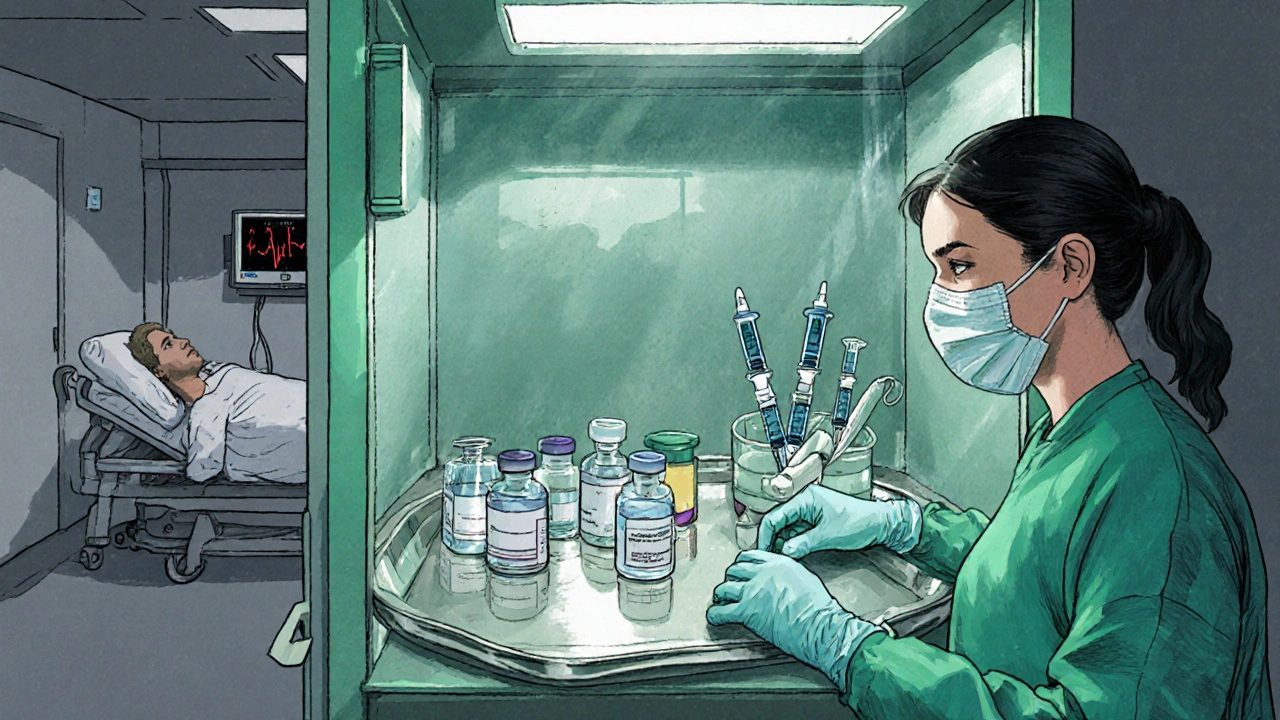Melphalan Dosing Calculator
Patient Information
Enter patient details to calculate appropriate melphalan dose
Dosing Results
Why a clear melphalan guide matters
High‑dose Melphalan is a nitrogen‑mustard alkylating agent used in the curative treatment of several blood cancers. A small miscalculation in **melphalan dosing** can mean the difference between a successful transplant and life‑threatening toxicity. This guide walks you through the facts you need to prescribe, prepare, and monitor melphalan safely.
Pharmacology at a glance
Melphalan works by cross‑linking DNA strands, preventing replication and ultimately triggering cell death. Its pharmacokinetics are dose‑dependent, with a half‑life of 90‑120 minutes after intravenous (IV) administration. The drug is primarily eliminated unchanged by the kidneys, making renal function the most critical factor for dose adjustments.
Key clinical indications
Although melphalan is approved for multiple conditions, two scenarios dominate daily practice:
- Multiple Myeloma is a plasma‑cell malignancy that often requires high‑dose melphalan as part of an autologous stem cell transplant (ASCT) conditioning regimen.
- Lymphoma (particularly Hodgkin and certain non‑Hodgkin subtypes) may be treated with melphalan in combination protocols or as a salvage agent.
Dosage calculations - the core of safe practice
Melphalan dosing is expressed in milligrams per square meter (mg/m²) of body surface area (BSA). The most common formulas are:
- Calculate BSA using the DuBois formula: BSA (m²) = 0.007184 × weight^0.425 (kg) × height^0.725 (cm).
- Multiply the BSA by the indication‑specific dose.
Typical regimens:
| Indication | Usual dose (mg/m²) | Frequency | Route |
|---|---|---|---|
| High‑dose conditioning for ASCT (multiple myeloma) | 200 mg/m² | Single dose | IV infusion |
| Lymphoma salvage | 100 mg/m² | Days 1 and 2 | IV infusion |
| Oral maintenance (low‑dose) | 0.25 mg/kg (rounded to nearest 2 mg) | Daily | Oral tablet |
Always round to the nearest 5 mg for IV and the nearest 2 mg for oral tablets, unless a specific protocol dictates otherwise.

Administration routes and practical tips
Melphalan is supplied as a sterile lyophilised powder for reconstitution (IV) and as 2 mg and 4 mg oral tablets. Follow these steps:
- IV infusion: Melphalan must be reconstituted with sterile water for injection to a concentration of 1 mg/mL. Dilute the solution further in 0.9% NaCl or D5W to a final volume of 250 mL for infusion over 30 minutes.
- Administer through a dedicated central line (preferably a tunneled catheter) to avoid extravasation.
- Perform the infusion in a negative‑pressure isolation room if the patient is neutropenic.
- Oral tablets should be swallowed with water; do not crush or chew as this increases mucosal toxicity.
Preparation, handling, and safety precautions
Melphalan is a hazardous drug. Pharmacy staff must use certified biological safety cabinets (Class II) and wear double gloves, a gown, and a mask. After reconstitution, keep the solution protected from light and use within 2 hours. Dispose of all waste according to local hazardous drug guidelines.
Monitoring parameters and managing toxicities
Key labs should be drawn before dosing and daily for 7 days post‑infusion:
- Complete blood count (CBC) - watch for nadir neutrophils < 0.5 × 10⁹/L.
- Serum creatinine and blood urea nitrogen - adjust dose if creatinine clearance < 40 mL/min.
- Liver enzymes (AST, ALT, bilirubin) - especially in patients with hepatic metastases.
- Electrolytes - melphalan can cause hyponatremia.
Common toxicities:
- Myelosuppression: anticipate a 10‑14 day aplastic phase; provide growth‑factor support (e.g., G‑CSF) as needed.
- Mucositis: prophylactic oral rinses (saline or chlorhexidine) reduce severity.
- Renal toxicity: maintain adequate hydration (≥2 L / day) and monitor urine output.
- Secondary malignancies: counsel patients on long‑term risk, especially after high‑dose regimens.

Dose adjustments for organ dysfunction
Because melphalan is renally cleared, dose reductions are essential for impaired kidneys:
- Creatinine clearance 30‑50 mL/min: reduce dose to 75% of calculated amount.
- Clearance < 30 mL/min: reduce to 50% or consider alternative conditioning.
Hepatic impairment (bilirubin > 2 × ULN) also warrants a 25‑30% dose reduction, though data are less robust than for renal function.
Practical checklist for the clinical team
- Confirm indication and target dose (mg/m²).
- Calculate patient BSA accurately; double‑check with a second clinician.
- Review latest labs - creatinine, bilirubin, CBC.
- Adjust dose per renal/hepatic guidelines.
- Order melphalan vials, sterile water, diluent, and infusion set.
- Pharmacy staff reconstitutes under hood, labels with patient ID, dose, and expiration time.
- Nurse verifies dose, checks line integrity, and starts infusion over 30 minutes.
- Provide anti‑emetic prophylaxis (e.g., ondansetron) and oral care kit.
- Monitor vitals and labs per protocol; document any adverse events.
- Post‑infusion, arrange for stem‑cell rescue (if applicable) and discharge planning.
Frequently Asked Questions
How is melphalan different from other alkylating agents?
Melphalan adds a phenylalanine side chain, which increases its lipophilicity. This allows better penetration into bone marrow and solid tumors, making it especially useful for high‑dose conditioning before stem‑cell transplant.
Can melphalan be given orally for high‑dose regimens?
No. Oral melphalan is limited to low‑dose maintenance (typically 0.25 mg/kg). High‑dose regimens require IV infusion to achieve the plasma concentrations needed for effective myeloablation.
What pre‑hydration protocol reduces renal toxicity?
Give 1 L of normal saline 30 minutes before infusion, then another 1 L during the infusion, followed by 500 mL over the next 6 hours. Adjust for cardiac status.
How long after melphalan can stem cells be reinfused?
Typically 24 hours after the high‑dose infusion, once the melphalan plasma level has fallen below 10 µg/mL. Exact timing depends on the conditioning protocol.
What are the signs of extravasation and how should they be managed?
Pain, erythema, and swelling at the infusion site indicate extravasation. Stop the infusion immediately, aspirate any residual drug, elevate the limb, and apply cold compresses for the first 24 hours. Consult the oncology pharmacy for antidote protocols.
Bottom line
When you nail the three pillars-accurate BSA‑based dosing, vigilant organ‑function adjustment, and disciplined infusion technique-melphalan can be a life‑saving weapon with manageable side effects. Keep this guide at hand, double‑check every calculation, and involve the multidisciplinary team early. Your attention to detail translates directly into better transplant outcomes and fewer complications.

Brandy Eichberger
October 21, 2025 AT 17:53One cannot overstate the elegance inherent in precise BSA calculations; a meticulous approach to melphalan dosing is the hallmark of true clinical sophistication. By adhering to the DuBois formula with unwavering rigor, we honor both the science and the patient. The rounding conventions-nearest 5 mg for IV and 2 mg for oral-serve as subtle yet powerful safeguards against inadvertent toxicity. It is, after all, the small details that distinguish a masterful practitioner from a merely competent one.
Chirag Muthoo
October 21, 2025 AT 20:39Thank you for highlighting the necessity of double‑checking BSA calculations; such diligence aligns perfectly with the standards of our profession. It is advisable to corroborate the computed dose with a colleague prior to administration to mitigate any risk of error. Moreover, maintaining a proactive stance on renal and hepatic function assessments will invariably enhance patient outcomes.
Ashok Kumar
October 21, 2025 AT 23:26Ah, the timeless ritual of asking a colleague to verify a simple formula-truly a marvel of modern medicine. One would think that such a routine could be automated, yet we persist in the archaic dance of human cross‑checking. In any case, the effort is commendable, if not mildly exhausting.
Angela Koulouris
October 22, 2025 AT 02:13Your emphasis on collaborative verification truly resonates; teamwork is the quiet engine behind safe oncology care. Keep championing that spirit, and the clinic will continue to thrive.
Harry Bhullar
October 22, 2025 AT 04:59When we dive into the practicalities of melphalan administration, it’s essential to appreciate the cascade of considerations that cascade from a single dose decision. First, the calculation of body surface area should be performed using a validated digital tool to avoid manual transcription errors. Once BSA is established, the prescribed milligram per meter‑squared value must be multiplied precisely, and the resultant figure rounded according to institutional protocol-5 mg increments for IV preparations, 2 mg for oral tablets. The next step involves confirming the patient’s most recent renal and hepatic function panels; any deviation from normal thresholds mandates a proportional dose reduction, typically to 75 % or 50 % of the calculated dose, depending on the severity of impairment. Prior to infusion, pharmacy staff must reconstitute the lyophilised powder in sterile water to achieve a 1 mg/mL concentration, then further dilute in isotonic saline or D5W to a total volume of 250 mL, ensuring the final solution is protected from light. During administration, a dedicated central line is preferred, and the infusion should be set to run over a 30‑minute period while the patient is monitored in a negative‑pressure isolation environment if neutropenia is present. Concurrently, pre‑hydration protocols-administering 1 L of normal saline 30 minutes before the infusion, followed by an additional 1 L during the infusion and a subsequent 500 mL over six hours-serve to attenuate nephrotoxicity. Post‑infusion, vigilant observation for signs of extravasation is crucial; any pain, erythema, or swelling must prompt immediate cessation of the line, aspiration of residual drug, limb elevation, and application of cold compresses for the first 24 hours. Laboratory monitoring should continue daily for at least a week, with particular attention to CBC nadir values, electrolytes, and hepatic enzymes. Finally, documenting every step-from dose calculation to infusion completion-in the electronic health record creates an immutable trail that supports both clinical accountability and quality improvement initiatives.
Dana Yonce
October 22, 2025 AT 07:46I love how the guide underscores the importance of pre‑hydration 😊 it really drives home the point that simple fluid management can make a huge difference in renal safety.
Lolita Gaela
October 22, 2025 AT 10:33From a pharmacokinetic perspective, the protocol’s emphasis on maintaining plasma melphalan concentrations below the 10 µg/mL threshold prior to stem‑cell reinfusion aligns with the therapeutic window required to maximize myeloablation while minimizing off‑target cytotoxicity. Moreover, the stipulated half‑life of 90‑120 minutes necessitates precise scheduling of adjunctive agents such as G‑CSF to synchronize neutrophil recovery with engraftment kinetics.
Giusto Madison
October 22, 2025 AT 13:19Listen up-if you’re not double‑checking that 5 mg rounding rule, you’re practically begging for trouble; get your act together and follow the checklist to the letter, because cutting corners is the fastest way to a malpractice nightmare.
erica fenty
October 22, 2025 AT 16:06Great summary; concise, clear-well done!!!
Xavier Lusky
October 22, 2025 AT 18:53They’re hiding the true risks behind glossy charts and slick protocols.